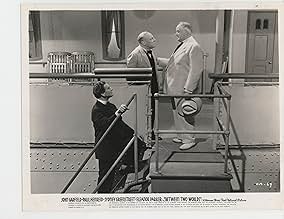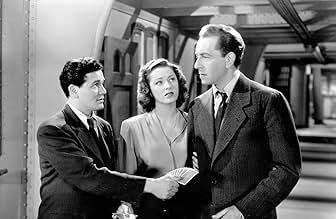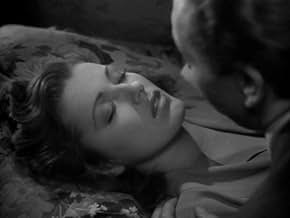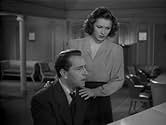IMDb-BEWERTUNG
7,1/10
2542
IHRE BEWERTUNG
Füge eine Handlung in deiner Sprache hinzuPassengers on an ocean liner can't recall how they got on board or where they are going yet, oddly enough, it soon becomes apparent that they all have something in common.Passengers on an ocean liner can't recall how they got on board or where they are going yet, oddly enough, it soon becomes apparent that they all have something in common.Passengers on an ocean liner can't recall how they got on board or where they are going yet, oddly enough, it soon becomes apparent that they all have something in common.
- Regie
- Drehbuch
- Hauptbesetzung
- Auszeichnungen
- 4 wins total
Sami Ayanoglu
- Davis
- (Nicht genannt)
Lester Matthews
- Steamship Dispatcher
- (Nicht genannt)
Patrick O'Moore
- Steamship Clerk
- (Nicht genannt)
Empfohlene Bewertungen
Between Two Worlds was a 1944 remake of the 1930 Leslie Howard film, Outward Bound, which was a hit on Broadway. This allegorical tale about death was the perfect World War II film and boasted a super ensemble cast--each and every cast member is wonderful. The stars, John Garfield, Paul Henreid, Eleanor Parker, and Sydney Greenstreet, give top-notch performances, but the film also boasts high points in the careers of Isobel Elsom, Faye Emerson, Dennis King, Sara Allgood, Gilbert Emery, and Edmund Gwenn. Each actor gets a share of the spotlight as they slowly discover their fate and face the final judgment. Nicely directed with a good set, although the music picks up bits from Casablanca. Moody and yes maybe talky by today's standards, but very effective and moving. My favorite is haughty Isobel Elsom, the great British actress who came to Hollywood in the mid 30s, after being one of England's biggest silent-film stars. She has the role Alison Skipworth played in the 1930 version, but her imperious demeanor takes on a whole new meaning in 1944, set against the war. This is the kind of film that can't be made any more, and when film-makers try, their efforts sink from view very quickly. Powerful and touching film filled with great moments. This one is a must see.
I finally had an opportunity to see this largely "forgotten" film, one of my favorites dealing in a mystical way with the afterlife. A remake of "Outward Bound" ('30), it was updated to World War II and begins with an air raid in which several people are unable to seek shelter. Afterwards, they find themselves on a strange ship and only gradually come to realize they are all dead--and about to be judged by a man called The Examiner (Sydney Greenstreet). The disparate group of people include some of the dependable Warner contract players: John Garfield, Eleanor Parker, Paul Henried, Faye Emerson, Edmund Gwenn, Isobel Elmson and Sara Allgood.
Thoughtful and well written (though talky and showing its stage origins), it permits us to examine the passengers one by one as they reveal their fears and foibles--each having substantial roles in a series of vignettes that will lead to their ultimate destination--heaven or hell.
It's fascinating, handsomely produced amid low-key film noir lighting and the performances are all first-rate. John Garfield and Paul Henried give the strongest performances in the meatiest roles but the others are all more than competent, including the lovely Eleanor Parker.
Erich Wolfgang Korngold's score happens to be one of his personal "favorites" and I can certainly see why. It is melancholy, lyrical and mysterious--in keeping with the "otherworldly" elements of a film about passengers on their way to another world.
An oddly interesting film, thought provoking and well worth viewing. It's a wonder no one has produced a remake since the material lends itself to endless possibilities.
Thoughtful and well written (though talky and showing its stage origins), it permits us to examine the passengers one by one as they reveal their fears and foibles--each having substantial roles in a series of vignettes that will lead to their ultimate destination--heaven or hell.
It's fascinating, handsomely produced amid low-key film noir lighting and the performances are all first-rate. John Garfield and Paul Henried give the strongest performances in the meatiest roles but the others are all more than competent, including the lovely Eleanor Parker.
Erich Wolfgang Korngold's score happens to be one of his personal "favorites" and I can certainly see why. It is melancholy, lyrical and mysterious--in keeping with the "otherworldly" elements of a film about passengers on their way to another world.
An oddly interesting film, thought provoking and well worth viewing. It's a wonder no one has produced a remake since the material lends itself to endless possibilities.
It's been years since I saw this on television, but it's one of the films I remember best. The plot deals with the most common cultural and spiritual views of the afterlife in a fascinating, allegorical way; it also deals with moral concerns about the way people live their lives. John Garfield is great, as usual. Some of the most wonderful, familiar character actors of old Hollywood bring much heart and integrity to well-defined roles.
This is a remake of the 1930 early-talkie "Outward Bound", which was based on the hit 1925 stage play. This version updates the period from the 1920's to the 1940's, and incorporates WW II elements into the story---a totally unnecessary tactic; the original play was quite good on its own and didn't need to have topical elements awkwardly sandwiched in. In fact,one of its strengths was that the entire unworldly experience seemed to take place in an unspecified time.
But this film has a very realistic beginning to it, and a war-related incident sets the plot in motion. The film's only serious blunder---though one that does not fatally affect it----is that we are tipped off as to what is really going on much too early in the film, in comparison to the 1930 film version, in which the characters realized their true situation at the same time as the audience did.
Aside from those objections, though, this is one of the few remakes which tops the original in nearly every department. Without exception, the actors in this version outdo the stiff, primitive early-talkie performances of their predecessors, and this may well be the only film in which Paul Henreid, normally not the most charismatic actor, gives a finer performance than the then-awkward Douglas Fairbanks,Jr. did in the same role in the 1930 film.
Especially outstanding are Edmund Gwenn as the ship's steward, Isobel Elsom as a rich, elderly, bitchy woman, Sydney Greenstreet as a mysterious character whose identity will not be revealed here, and Sara Allgood in one of the most sensitive performances of her career (she acts rings around Beryl Mercer from the 1930 version). George Coulouris, a reliable villain in those days (he was Orson Welles' nasty guardian in "Citizen Kane") is sinister and pompous as a greedy tycoon. And John Garfield is excellent in the Leslie Howard role, altered some to fit Garfield's tough, bitter on-screen persona rather than Howard's ultra-sophisticated, debonair one. (Garfield,though,does not go as berserk when he finds out the truth as Howard so hilariously did in the 1930 version.)
Although much of the dialogue in the first half has been changed and perhaps made slightly less "literary", the second half,which features Sydney Greensteet, is quite faithful to the earlier film and the stage play. Erich Wolfgang Korngold's music runs through nearly every scene, and, although verging toward the bombastic and melodramatic at times, lends plenty of atmosphere to the story.
One unfortunate aspect is that the photography in this version never becomes as eerie as that in the 1930 version, with its striking light and darkness effects. But none of these faults should keep you away from this film, which deserves far better than its relative obscurity in comparison to the other great Warner Bros. classics as well as other films dealing with the afterlife.
But this film has a very realistic beginning to it, and a war-related incident sets the plot in motion. The film's only serious blunder---though one that does not fatally affect it----is that we are tipped off as to what is really going on much too early in the film, in comparison to the 1930 film version, in which the characters realized their true situation at the same time as the audience did.
Aside from those objections, though, this is one of the few remakes which tops the original in nearly every department. Without exception, the actors in this version outdo the stiff, primitive early-talkie performances of their predecessors, and this may well be the only film in which Paul Henreid, normally not the most charismatic actor, gives a finer performance than the then-awkward Douglas Fairbanks,Jr. did in the same role in the 1930 film.
Especially outstanding are Edmund Gwenn as the ship's steward, Isobel Elsom as a rich, elderly, bitchy woman, Sydney Greenstreet as a mysterious character whose identity will not be revealed here, and Sara Allgood in one of the most sensitive performances of her career (she acts rings around Beryl Mercer from the 1930 version). George Coulouris, a reliable villain in those days (he was Orson Welles' nasty guardian in "Citizen Kane") is sinister and pompous as a greedy tycoon. And John Garfield is excellent in the Leslie Howard role, altered some to fit Garfield's tough, bitter on-screen persona rather than Howard's ultra-sophisticated, debonair one. (Garfield,though,does not go as berserk when he finds out the truth as Howard so hilariously did in the 1930 version.)
Although much of the dialogue in the first half has been changed and perhaps made slightly less "literary", the second half,which features Sydney Greensteet, is quite faithful to the earlier film and the stage play. Erich Wolfgang Korngold's music runs through nearly every scene, and, although verging toward the bombastic and melodramatic at times, lends plenty of atmosphere to the story.
One unfortunate aspect is that the photography in this version never becomes as eerie as that in the 1930 version, with its striking light and darkness effects. But none of these faults should keep you away from this film, which deserves far better than its relative obscurity in comparison to the other great Warner Bros. classics as well as other films dealing with the afterlife.
Sutton Vane's play Outward Bound was expanded and souped up considerably in this second screen version of the play, Between Two Worlds. The basic ideas of the play and first film have been extended and accommodated to World War II. Several new characters were introduced into the screenplay.
Paul Henreid and Eleanor Parker play a young couple who decide to take their own lives via a gas stove. Earlier in the day they saw several people killed when a bomb hits a bus during the Blitz. Parker and Henreid then find themselves on a fog enclosed ship with those same people they saw and a steward played by Edmund Gwenn.
In the original play these people were all British, but because of the wartime alliance some Americans got in on the act. Cynical reporter John Garfield, charwoman Sara Allgood, millionaire George Coulouris and his traveling companion Faye Emerson who used to have a thing with Garfield, vicar Dennis King, merchant sailor George Tobias, and a proper middle class British couple Gilbert Emery and Isobel Elsom.
It takes a while, but soon the others catch on to what Parker and Henreid know already that they're dead. Gwenn informs them that at the end of the voyage they will meet The Great Examiner.
Taking the place of Dudley Digges who played The Great Examiner on stage and in the first film version of Outward Bound is Sydney Greenstreet. The one guy who's relieved at this turns out to be King who recognizes him as an old chum from seminary. Apparently this is how clergy people are used in the next life.
Leslie Howard played the role John Garfield has on stage and in the first version. It was interesting seeing both films back to back to see how two very different actors interpreted and how the screenplay was adapted to fill John Garfield's rebel persona.
George Couloris's character is fleshed out a great deal more in this than in the original version. On screen Montagu Love played it and the man's sins were strictly mercenary. Here he's accompanied by his tootsie Faye Emerson and there's carnal lust in the mix as well as avarice.
Alison Skipworth played Isobel Elsom's part on screen first and in that version, Mrs. Cliveden-Banks is already a widow. Here her husband is brought into the plot, played by Gilbert Emery and her eternal fate is different from the original.
Daniel Fuchs in adapting and expanding the screenplay did manage to still preserve Sutton Vane's message about your eternal fate hanging in the balance of how you live life. Between Two Worlds is still an entertaining fantasy with a strong moral to it.
Paul Henreid and Eleanor Parker play a young couple who decide to take their own lives via a gas stove. Earlier in the day they saw several people killed when a bomb hits a bus during the Blitz. Parker and Henreid then find themselves on a fog enclosed ship with those same people they saw and a steward played by Edmund Gwenn.
In the original play these people were all British, but because of the wartime alliance some Americans got in on the act. Cynical reporter John Garfield, charwoman Sara Allgood, millionaire George Coulouris and his traveling companion Faye Emerson who used to have a thing with Garfield, vicar Dennis King, merchant sailor George Tobias, and a proper middle class British couple Gilbert Emery and Isobel Elsom.
It takes a while, but soon the others catch on to what Parker and Henreid know already that they're dead. Gwenn informs them that at the end of the voyage they will meet The Great Examiner.
Taking the place of Dudley Digges who played The Great Examiner on stage and in the first film version of Outward Bound is Sydney Greenstreet. The one guy who's relieved at this turns out to be King who recognizes him as an old chum from seminary. Apparently this is how clergy people are used in the next life.
Leslie Howard played the role John Garfield has on stage and in the first version. It was interesting seeing both films back to back to see how two very different actors interpreted and how the screenplay was adapted to fill John Garfield's rebel persona.
George Couloris's character is fleshed out a great deal more in this than in the original version. On screen Montagu Love played it and the man's sins were strictly mercenary. Here he's accompanied by his tootsie Faye Emerson and there's carnal lust in the mix as well as avarice.
Alison Skipworth played Isobel Elsom's part on screen first and in that version, Mrs. Cliveden-Banks is already a widow. Here her husband is brought into the plot, played by Gilbert Emery and her eternal fate is different from the original.
Daniel Fuchs in adapting and expanding the screenplay did manage to still preserve Sutton Vane's message about your eternal fate hanging in the balance of how you live life. Between Two Worlds is still an entertaining fantasy with a strong moral to it.
Wusstest du schon
- WissenswertesComposer Erich Wolfgang Korngold named this film as his personal favorite among his film scores.
- PatzerWhen the Bergners first arrive aboard the ship, the shadow of a klieg light can be seen on one of the double doors as they pass through.
- Alternative VersionenTwo versions of the movie exist. The latest, published by Warner Archive in Sept. 2006, is the 112 minute cut. Another version of 121 minutes, including a rarely seen cut scene between Ann and Tom and a few additional shots of the casino parts, has been broadcast by a few TV networks in the 2000s in Europe and East Asia.
- VerbindungenFeatured in Between Two Worlds: Erich Wolfgang Korngold (2005)
Top-Auswahl
Melde dich zum Bewerten an und greife auf die Watchlist für personalisierte Empfehlungen zu.
Details
- Erscheinungsdatum
- Herkunftsland
- Sprache
- Auch bekannt als
- Entre dos mundos
- Drehorte
- Produktionsfirma
- Weitere beteiligte Unternehmen bei IMDbPro anzeigen
- Laufzeit1 Stunde 52 Minuten
- Farbe
- Seitenverhältnis
- 1.37 : 1
Zu dieser Seite beitragen
Bearbeitung vorschlagen oder fehlenden Inhalt hinzufügen

Oberste Lücke
By what name was Zwischen zwei Welten (1944) officially released in India in English?
Antwort


































